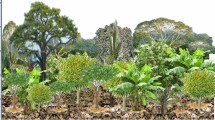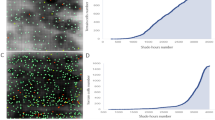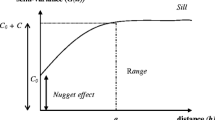Abstract
Complex agroforestry systems are known to be less conducive to the dispersion of plant pathogenic germs. These systems, which combine many species components provide a means of improving environmental and regulatory mechanisms of disease. The spatial structure, which is a basic characteristic of these systems, has often been indicated as one of the ecological pest control tool. This study was conducted to identify the interaction between the spatial structure of citrus in cocoa agroforests and the severity of Phytophthora foot rot disease of citrus (PFRDC) in the humid zones of Cameroon. The spatial structure of 19 cocoa based agroforests selected in three sites was analysed by L(r) Ripley modified function. The three sites were selected in two forest zones and in a savannah-forest transition zone. Disease severity was characterized on 438 citrus trees, during three rainy seasons and leaf flare periods. The biodiversity of this system was thus proven and in general, the spatial structure of citrus in the plots was random tend to be regular or aggregate. Plots with aggregate and random spatial structure were significantly attacked by PFRDC compared to regular spatial structure. This allows not only to demonstrate the involvement of the spatial structure of citrus on developing PFRDC in this culture system, but already opens a way for improvement of cocoa agroforests in terms of its structure.





Similar content being viewed by others
References
Beer J, Muschler R, Kass D, Somarriba E (1997) Shade management in coffee and cocoa plantations. Agrofor Syst 38(13):139–164
Bowers JH, Sonoda RM, Mitchell DJ (1990) Path coefficient analysis of the effect of rainfall variables on the epidemiology of Phytophthora blight of pepper Phytophthora capsici caused by. Phytopathology 80:1439–1446
Brown DH, Bolker BM (2004) The effects of disease dispersal and host clustering on the epidemic threshold in plants. Bull Math Biol 66(2):341–371
Cacciola SO, Di San Lio GM (2008) Management of citrus diseases caused by Phytophthora spp. In: Ciancio A, Mukerji KG (eds) Integrated management of diseases caused by fungi, bacteria and Phytoplasma. Springer, Netherlands, pp 61–84
Calonnec A, Burie JB, Langlais M, Guyader S, Saint-Jean S, Sache I, Tivoli B (2013) Impacts of plant growth and architecture on pathogen processes and their consequences for epidemic behaviour. Eur J Plant Pathol 135:479–497
Dewdney MM, Timmer LW 2010. Citrus scab. In: Rogers ME, Dewdney MM, Spann TM (eds) Florida citrus pest management guide: University of Florida, IFAS, Doidge and Bottomley 1931, p 3
Di San Lio MG (1994) Integrated management of bacterial and fungal diseases of citrus in the Mediterranean area. Proc Int Soc Citrus Grow 3:1273–1277
Futch SH, Graham JH (2012) Field diagnosis and management of Phytophthora diseases, Institute of Food and Agricultural Sciences, University of Florida, Gainesville. http://edis.ifas.ufl.edu
Gidoin C (2013) Relations entre structure du peuplement végétal et bioagresseurs dans les agroforêts à cacaoyers. Application à trois bioagresseurs du cacaoyer: la moniliose au Costa Rica, la pourriture brune et les mirides au Cameroun. Thèse de doctorat, Centre International d’Etudes Supérieures en Sciences Agronomiques de Montpellier
Gidoin C, Babin R, Bagny Beilhe L, Cilas C, Ten Hoopen GM, Ngo Bieng MA (2014) Tree spatial structure, composition and host resource availability influenced mirid density of black pod prevalence in cocoa agroforests in Cameroon. PLoS ONE 9(10):e109405
Goreaud F (2000) Apports de l’analyse de la structure spatiale en forêt tempérée à l’étude et à la modélisation des peuplements complexes., PhD thesis, L’ENGREF, Centre de Nancy, France
Graham JH (1995) Root regeneration and tolerance of citrus rootstocks to root rot caused by Phytophthora nicotianae. Phytopathology 85:111–117
Graham JH, Timmer LW (2006) Phytophthora diseases of citrus. University of Florida, IFAS Extension. http://edis.ifas.ufl.edu/CH087
Hirst JM, Stedman OJ (1960) The epidemiology of Phytophthora infestans; the source of inoculum. Ann Appl Biol 48:489–517
Kuate J (1998) Cercospora leaf and spot disease of citrus caused by Phaeoramularia angolensis. Cah Agric 7:121–129
Kuate J, Manga Bella, Damesse F, Kouodiekong L, Ndindeng SA, David O, Parrot L (2006) Fruit trees cultivated in family farms in the humid area of Cameroon: a survey. Fruits 61(6):373–387
Madden LV (1998) Rain-splash and spore dispersal a physical perspective. In: Jones DG (ed) The epidemiology of plant diseases. Kluwer, London, pp 348–370
Mitchell EC, Tilman D, Groth JV (2002) Effects of grassland plant species diversity, abundance, composition and foliar fungal disease is. Ecology 83(6):1713–1726
Ndo EGD (2007) Analyse du risque épidémiologique des populations d’agrumes vis à vis de la cercosporiose, du scab et de la gommose dans les zones humides du Cameroun. Thèse de MSc, Faculté d’Agronomie et des Sciences Agricoles Université de Dschang, Cameroun
Ndo EGD, Bella-Manga F, Ndindeng SA, Ndoumbe-Nkeng M, Fontem AD, Cilas C (2010) Altitude, tree species and soil type are the main factors influencing the severity of Phaeoramularia leaf and fruit spot disease of citrus in the humid zones of Cameroon. Eur J Plant Pathol 128:385–397
Neher D, Duniway JM (1992) Dispersal of Phytophthora parasitica in tomato fields by furrow irrigation. Plant Dis 76:582–586
Ngo Bieng MA, Gidoin C, Avelino J, Cilas C, Deheuvels Wery J (2013) Diversity and spatial clustering of shade trees affect cacao yield and pathogen pressure in Costa Rican agroforests. Basic Appl Ecol 14:329–336
Oro FZ, Bonnot F, Ngo-Bieng MA, Delaitre E, Dufour BP, Ametefe KE, Mississo E, Wegbe K, Muller E, Cilas C (2012) Spatiotemporal pattern analysis of Cacao swollen shoot virus in experimental plots in Togo. Plant Pathol 61(6):1043–1051
Rao MR, Nair PKR, Ong CK (1998) Biophysical interactions in tropical agroforestry systems. Agrofor Syst 38:3–50
Ratnadass A, Fernandes P, Avelino J, Habib R (2012) Plant species diversity for sustainable management of crop pests and diseases in agroecosystems. Agrofor Sustain Dev 32(1):273–303
Shew HD (1987) Effect of host resistance is spread of Phytophthora parasitica var. Subsequent development and nicotianae of tobacco black shank under field conditions. Phytopathology 77:1090–1093
Sonwa DJ, Nkongmeneck BA, Weise SF, Tchatat M, Adesina AA, Janssens MJJ (2007) Diversity of plants in cocoa agroforests in humid forest areas of Southern Cameroon. Biodiv Conserv 16:2385–2400
Temple L (2001) Quantification of fruit production and vegetable trade in Cameroon. Cah Agric 10:87–94
Zwankhuizen J, Govers F, Zadoks JC (1998) Development of potato late blight epidemics: disease foci, disease gradients, and infection sources. Phytopathology 88:754–763
Acknowledgements
The Cameroon Institute of Agricultural Research for Development (IRAD); The Centre International de Recherche Agronomique pour le Développement (CIRAD) through his incentive share for the financing of student’s work; the CORAF projects “Optimizing productivity and perennial intercrop diversity Tradeoffs in West and Central African cocoa farms (Tradeoffs in cocoa)” and “Enhancing food security and well-being of rural African Households through Improved synergy between Agroforestry Systems and Food crops.” That funded this work; the populations of Zima-Mbakomo, Ikata and Boyambassa villages. Especially to AMADAGANA Francois, Emmanuel and NGA Marcus.
Author information
Authors and Affiliations
Corresponding author
Rights and permissions
About this article
Cite this article
Akoutou Mvondo, E., Ndo, E.G.D., Ngo Bieng, MA. et al. Assessment of the interaction between the spatial organization of citrus trees populations in cocoa agroforests and Phytophthora foot rot disease of citrus severity. Agroforest Syst 93, 493–502 (2019). https://doi.org/10.1007/s10457-017-0140-3
Received:
Accepted:
Published:
Issue Date:
DOI: https://doi.org/10.1007/s10457-017-0140-3




